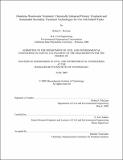| dc.contributor.advisor | E. Eric Adams. | en_US |
| dc.contributor.author | McLean, Robert C. (Robert Charles) | en_US |
| dc.contributor.other | Massachusetts Institute of Technology. Dept. of Civil and Environmental Engineering. | en_US |
| dc.coverage.spatial | ncho--- | en_US |
| dc.date.accessioned | 2010-03-24T20:34:42Z | |
| dc.date.available | 2010-03-24T20:34:42Z | |
| dc.date.copyright | 2009 | en_US |
| dc.date.issued | 2009 | en_US |
| dc.identifier.uri | http://hdl.handle.net/1721.1/52759 | |
| dc.description | Thesis (M. Eng.)--Massachusetts Institute of Technology, Dept. of Civil and Environmental Engineering, 2009. | en_US |
| dc.description | Includes bibliographical references (leaves 76-78). | en_US |
| dc.description | This electronic version was submitted by the student author. The certified thesis is available in the Institute Archives and Special Collections. | en_US |
| dc.description.abstract | (cont.) However, it is doubtful the costs associated with dosages required to achieve these removals are sustainable for communities such as Las Vegas. To address these deficiencies further sustainable practices for optimizing the Imhoff tanks as well as designs for both pre-treatment and secondary treatment options appropriate for use in Honduras were developed. The recommended system allows achievement of regulatory effluent levels while maintaining low annual operating costs for the system. | en_US |
| dc.description.abstract | Wastewater treatment within Honduras is indicative of the state of water and sanitation services throughout the developing portions of Central America. One technology which comprises approximately 40 percent of all treatment facilities within Honduras is the Imhoff tank. First patented in 1906 the Imhoff tank has long been out of favor within the developed world as newer technologies and large centralized processing of wastewater have developed. Nevertheless, Imhoff tanks remain appropriate primary treatment technology for decentralized facilities like those found throughout Honduras. A large number of Honduras' systems have fallen into various states of disrepair due to neglect through lack of proper maintenance. One system within the municipality of Las Vegas, Honduras was examined extensively to determine the appropriateness of rehabilitating these systems utilizing various enhancement technologies. Water quality measurements were obtained for the Las Vegas system, which was found to be providing only negligible removals of wastewater constituents. Two large factors figuring into this are: measured flow rates were approximately 50 percent higher than originally anticipated in design and routine maintenance on the system has been neglected. Utilizing chemically enhanced primary treatment with ferric chloride as a coagulant, it was possible to increase removal efficiencies and achieve regulatory effluent standards for chemical oxygen demand, turbidity, and pH, despite the high flows. | en_US |
| dc.description.statementofresponsibility | by Robert C. McLean. | en_US |
| dc.format.extent | 100 leaves | en_US |
| dc.language.iso | eng | en_US |
| dc.publisher | Massachusetts Institute of Technology | en_US |
| dc.rights | M.I.T. theses are protected by
copyright. They may be viewed from this source for any purpose, but
reproduction or distribution in any format is prohibited without written
permission. See provided URL for inquiries about permission. | en_US |
| dc.rights.uri | http://dspace.mit.edu/handle/1721.1/7582 | en_US |
| dc.subject | Civil and Environmental Engineering. | en_US |
| dc.title | Honduras wastewater treatment : chemically enhanced primary treatment and sustainable secondary treatment technologies for use with Imhoff tanks | en_US |
| dc.type | Thesis | en_US |
| dc.description.degree | M.Eng. | en_US |
| dc.contributor.department | Massachusetts Institute of Technology. Department of Civil and Environmental Engineering | |
| dc.identifier.oclc | 501942743 | en_US |
